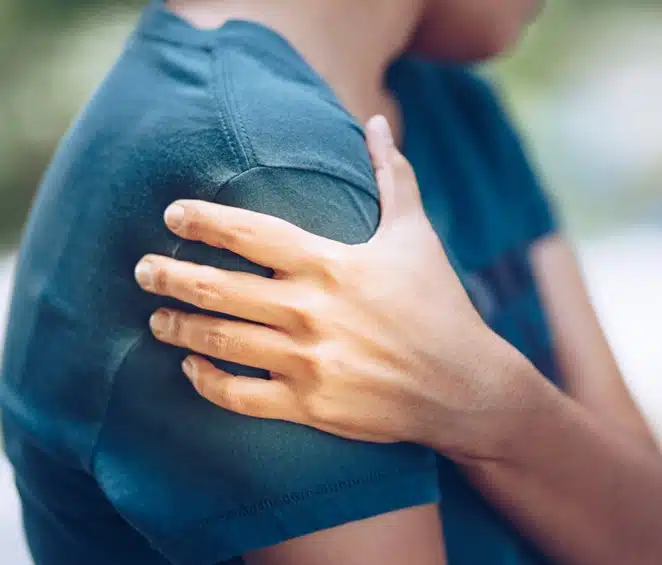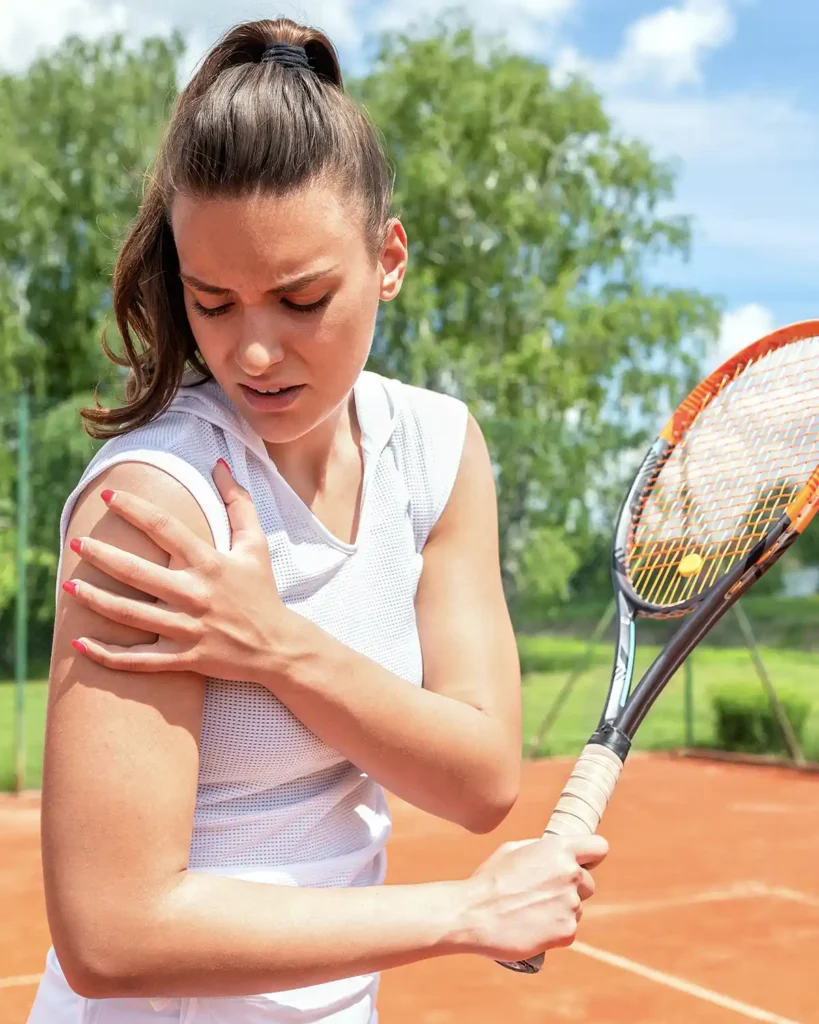This website uses cookies so that we can provide you with the best user experience possible. Cookie information is stored in your browser and performs functions such as recognising you when you return to our website and helping our team to understand which sections of the website you find most interesting and useful.

Often caused by repetitive overuse of the tendons, such as from injuries. It generally happens when your arm is raised when throwing, swimming, or playing racket sports. Raising your arm repeatedly, affects the tight archway of bone and ligament, becoming compressed against the tendons tendons bursa. Repetitive arm movements can cause the tendons and bursa to fray, resulting in inflammation and shoulder tendonitis pain.
It’s essential for patients with shoulder tendonitis to work closely with our Orthopedic team to ensure they follow a comprehensive treatment plan that meets their specific medical needs and goals.

Shoulder tendonitis, also known as rotator cuff tendonitis, refers to inflammation of the tendons in the rotator cuff, a group of muscles and their associated tendons that stabilize the shoulder joint. There are several types of shoulder tendonitis, each involving inflammation of a specific tendon within the rotator cuff or in the surrounding shoulder region.
Types of shoulder tendonitis:
Supraspinatus Tendonitis is one of the four tendons of the rotator cuff. Supraspinatus tendonitis involves inflammation of the supraspinatus tendon, which runs along the top of the shoulder blade (scapula) and helps to lift the arm away from the body (abduction).
Infraspinatus Tendonitis the infraspinatus tendon is another tendon of the rotator cuff, located on the back of the shoulder blade. Infraspinatus tendonitis involves inflammation of the infraspinatus tendon, which helps to rotate the arm and stabilize the shoulder externally.
Subscapularis Tendonitis is located on the front of the shoulder blade and is the largest and strongest tendon of the rotator cuff. Subscapularis tendonitis involves inflammation of the subscapularis tendon, which helps to rotate the arm and stabilize the shoulder joint internally.
Biceps Tendonitis involves inflammation of the long head of the biceps tendon, which runs from the front of the shoulder and attaches to the top of the shoulder socket (glenoid). Biceps tendonitis can occur in isolation or in conjunction with rotator cuff tendonitis and is often associated with repetitive overhead activities.
Shoulder Impingement Syndrome is not strictly tendonitis. It involves compression or pinching of the rotator cuff tendons and the subacromial bursa (a fluid-filled sac) between the acromion (a bony projection of the shoulder blade) and the humeral head (the ball-shaped end of the upper arm bone). Shoulder impingement can lead to inflammation of the rotator cuff tendons and bursa, causing pain and a limited range of motion.
Calcific Tendonitis occurs when calcium deposits build up within the rotator cuff tendons, leading to inflammation and pain. These deposits can cause irritation of the surrounding tissues and may contribute to tendon degeneration if left untreated.
These are the main types of shoulder tendonitis, each involving inflammation of specific tendons within the rotator cuff or in the surrounding shoulder region. Treatment for shoulder tendonitis typically involves rest, ice, physical therapy, anti-inflammatory medications, and, in some cases, corticosteroid injections or surgery for refractory cases.
It’s important to consult our medical team for an accurate diagnosis and appropriate treatment plan.
If you are experiencing tendonitis in your shoulders and need medical care, please contact Dr. Stephen W. Pournaras, and our professional medical staff can help you recover by simply contacting us today.
The symptoms of shoulder tendonitis, also known as rotator cuff tendonitis, can vary depending on the specific tendon involved and the severity of inflammation.
Pain is the most common symptom of shoulder tendonitis. The pain may be dull, achy, or sharp, and it is often felt deep within the shoulder. The pain may worsen with specific movements or activities, such as reaching overhead, lifting objects, or sleeping on the affected side.
Tenderness may be present over the affected tendon or around the shoulder joint. Palpating or pressing on the tendon may elicit pain or discomfort.
Stiffness and reduced range of motion in the shoulder joint are common symptoms of tendonitis. The shoulder may feel tight or difficult to move, particularly when lifting the arm or reaching behind the back.
Weakness in the shoulder muscles, particularly those involved in lifting or rotating the arm, may occur due to pain and inflammation. This weakness can affect the ability to perform daily activities or participate in sports or exercise.
Swelling or inflammation may occur in the shoulder joint or over the affected tendon. The shoulder may appear swollen or feel puffy to the touch.
Pain at Rest in some cases may occur even at rest, particularly during periods of prolonged immobility or when lying on the affected side.
Painful Activities or movements that involve the shoulder joint may exacerbate symptoms of tendonitis. These activities may include lifting objects, reaching overhead, throwing, or sleeping on the affected side.
Painful Clicking or Snapping in some cases, tendonitis may be associated with clicking or snapping sensations in the shoulder joint, particularly during movement. This may be due to irritation of the tendon or inflammation of the surrounding tissues.
It’s important to note that symptoms of shoulder tendonitis can vary from person to person, and some patients may experience more severe symptoms than others. If you experience persistent shoulder pain or other symptoms suggestive of tendonitis, it’s important to consult our medical team for an accurate diagnosis and appropriate treatment. Early intervention can help prevent worsening of symptoms and promote faster recovery.
Treatment for tendonitis, including shoulder or rotator cuff tendonitis, involves a combination of self-care measures, non-surgical treatments, and, in some cases, medical interventions.
Rest is essential to allow the affected tendon to heal. Avoid activities that aggravate symptoms and give the tendon time to recover. In some cases, immobilization with a sling or brace may be necessary to minimize stress on the tendon.
Ice Therapy, applying ice to the affected area, can help reduce pain and inflammation. Use an ice pack or ice wrapped in a cloth for 15-20 minutes several times daily, especially after activities that exacerbate symptoms.
Nonsteroidal Anti-Inflammatory Drugs (NSAIDs): Over-the-counter NSAIDs such as ibuprofen (Advil, Motrin) or naproxen (Aleve) can help reduce pain and inflammation associated with tendonitis. Follow the recommended dosage and use caution if you have any underlying medical conditions.
Physical Therapy play a crucial role in treating tendonitis. A physical therapist can provide exercises to stretch and strengthen the muscles around the shoulder joint, improve flexibility, and correct any biomechanical imbalances that may contribute to tendonitis. Modalities such as ultrasound, electrical stimulation, or manual therapy techniques may also be used to reduce pain and promote healing.
Activity Modification: Modify activities or sports that exacerbate symptoms of tendonitis. Avoid repetitive overhead movements, heavy lifting, or activities that stress the affected tendon excessively. Gradually reintroduce activities as symptoms improve and with guidance from our medical team.
Corticosteroid Injections: In cases of severe pain or inflammation that do not respond to conservative treatments, Dr. Pournaras may recommend a corticosteroid injections into the affected tendon or the surrounding area. Corticosteroids can help reduce inflammation and provide temporary pain relief, but they should be used judiciously due to potential side effects.
Platelet-Rich Plasma (PRP) Therapy: PRP therapy involves injecting concentrated platelets from the patient’s own blood into the affected tendon to promote healing. PRP therapy may be considered for chronic or refractory cases of tendonitis, although evidence for its effectiveness is mixed.
Extracorporeal Shockwave Therapy (ESWT): ESWT is a non-invasive procedure that uses shockwave energy to stimulate healing in the affected tendon. ESWT may be considered for chronic tendonitis that has not responded to other treatments.
Surgery: In rare cases of severe or chronic tendonitis that do not respond to conservative treatments, surgery may be necessary. Surgical options may include tendon debridement (removal of damaged tissue), tendon repair, or in some cases, tendon transfer or reconstruction.
It’s important to consult our medical team for an accurate diagnosis and appropriate treatment plan for tendonitis. Early intervention and proper management can help reduce pain, improve function, and promote healing of the affected tendon.
Surgical options for shoulder tendonitis, particularly rotator cuff tendonitis, are considered when non-surgical treatments have failed to address the condition adequately or in cases of severe tendon damage or chronic degeneration.
Surgery can repair the damaged tendon, alleviate pain, and restore function to the shoulder.
Rotator Cuff Repair: Rotator cuff repair is a surgical procedure to repair torn or damaged tendons in the rotator cuff. During this procedure, Dr. Pournaras will reattach the torn tendon to the bone using sutures or anchors. Depending on the size and location of the tear, rotator cuff repair can be performed using arthroscopic or open surgical techniques.
Subacromial Decompression: Subacromial decompression is a surgical procedure used to relieve pressure on the rotator cuff tendons and the subacromial bursa (a fluid-filled sac) beneath the acromion (a bony projection of the shoulder blade). During this procedure, Dr. Pournaras will remove a small portion of the acromion or the bursa to create more space for the rotator cuff tendons, reducing the risk of impingement and inflammation.
Acromioplasty is a type of subacromial decompression procedure that involves shaving down or removing a portion of the acromion to alleviate pressure on the rotator cuff tendons. This procedure may be combined with rotator cuff repair or performed as a standalone procedure for impingement syndrome.
Biceps Tenodesis is a surgical procedure used to address the long head of the biceps tendon pathology, which can contribute to shoulder tendonitis. During this procedure, Dr. Pournaras will detach the biceps tendon from its original attachment in the shoulder joint and reattach it to a different location on the humerus (upper arm bone). This helps to alleviate pain and prevent further tendon damage.
Tendon Transfer: In cases of severe rotator cuff tendonitis or irreparable tendon tears, tendon transfer procedures may be considered. Tendon transfer involves transferring a healthy tendon from another part of the body to replace the damaged or deficient rotator cuff tendon. This can help restore shoulder function and stability.
Debridement: In some cases of chronic tendonitis with degenerative changes, surgical debridement may be performed to remove damaged or diseased tissue from the affected tendon. Debridement procedures aim to alleviate pain and improve tendon healing.
PRP Injection: Platelet-rich plasma (PRP) injection may be used as an adjunct to surgical treatment for shoulder tendonitis. PRP therapy involves injecting concentrated platelets from the patient’s own blood into the affected tendon to promote healing and tissue regeneration.
The choice of surgical procedure will depend on various factors, including the underlying cause of tendonitis, the extent of tendon damage, and the patient’s overall health and functional goals. It’s important to discuss the risks, benefits, and potential outcomes of surgery with Dr. Pournaras to determine the most appropriate treatment approach for shoulder tendonitis.
Make Your Appointment Today
Fair Oaks Orthopedics – Fairfax,VA


